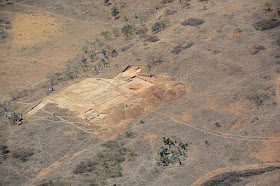The Alan are deformed spirits from the folklore of the Tinguian tribe of the Philippines. They have wings and can fly, and their fingers and toes point backward.
These weird creatures have been known to shelter human children who have been left to their own devices in the harsh, jungle terrain of the Philippine Islands.
Supposedly hailing from the dense jungles of the Philippine Islands, this mysterious race of small, deformed half-human, half-avian creatures, are known for their mischievous antics. Locals claim that these beasts dwell in the deep shadow ridden abyss of the Philippine rain forests, where they spend the better part of their days hanging upside down from trees in a bat-like fashion.
Appearance:
The skin on the face of a " wizened old alan” is described in a Tinguian tale as having been tough like carabao hide. The alan’s long arms had fingers pointing back from the wrist, “horrible to look at.” Elsewhere, the alan are said to be: “. . . as large as people but have wings and can fly. Their toes are at the back of their feet and their fingers point backward from their wrists.”
Legend:
The Alan and the Hunters:
Two men once went to hunt wild pig in the mountains, and after some time they speared and killed one, but they had no fire over which to singe it.
One man climbed a tree to see if there was a fire near by, and discovering smoke at some distance, he started toward it. When he reached the place, he found that the fire was in the house of an Alan, and he was very much afraid; but creeping up into the house, he found that the Alan and her baby were fast asleep.
He stepped on tip-toe, but nevertheless the Alan was awakened and called out:
“Epogow, what do you want?”
“I should like to get some fire,” said the man, “for we have killed a wild pig.”
The Alan gave him the fire, and then taking her basket she went with him to the place where the pig was.
After they had singed the animal, the Alan cut it up with her long nails and handed the liver to the man, telling him to take it to her house to feed the baby.
The man started, and on the way he ate the liver. When he reached the Alan’s house he did not know what to do. For some time he looked around, and then seeing a large cauldron of hot water on the fire, he threw the baby into it and went back.
“Did the baby eat well?” asked the Alan.
“Very well,” said the man.
Then she put most of the meat into her basket and started home. As soon as she had gone, the man told his companion what he had done, and they were so frightened that they ran to hide.
When the Alan reached home and found the baby dead in the hot water, she was very angry and started back immediately to find the men, who, in the meantime, had climbed a high tree that stood near the water.
The Alan looked down into the water, and seeing the reflection of the men, she reached in her long hand with the fingers that pointed backward, but when she could not touch them, she looked up and saw them in the tall tree.
“How did you get up there?” she cried angrily.
“We climbed up feet first,” called down the men.
The Alan, determined to get them, caught hold of a vine and started up the tree feet first, but before she quite reached them, they cut the vine and she fell to the ground and was killed.
Then the men came down and went to the Alan’s house, where they found a jar full of beads and another of gold, and these they brought with them when they returned home.
The Man and the Alan:
A Tinguian was once walking along a trail in the woods when he heard a strange sound in a large tree near him, and looking up he was startled to see that it was the home of the Alan-spirits who live in the wood.
He stopped and gazed for a moment at the horrible creatures, large as people, hanging from the limbs of the tree with their heads down like bats. They had wings to fly, and their toes were at the back of their feet, while their long fingers, which pointed backward, were fastened at the wrist.
"Surely," thought the man, "these terrible beings will eat me if they can catch me. I will run away as fast as I can while they are asleep." He tried to run but he was too frightened, and after a few steps he fell face down on the ground.
At this the Alan began to wail loudly, for they saw him fall and believed him dead. They came down out of the tree with gold and beads which they laid on him.
After a while the man gathered courage and, jumping up, he cried as loudly as he could, "Go away!"
The Alan did not move, but they looked at him and said: "Give us the one bead nagaba [a peculiar bead of double effect], and you may have the rest." When the man refused to do this, they were angry and turned away, crying, "Then we are going to burn your house, for you are a bad man."
Thereupon the man went home as fast as he could go, but very soon after that his house burned, for the Alan kept their word.
And then...This Alan creature passed his legacy on to those that came forth and were worthy creatures of the gift. So, from generation to generation the Alan creatures can be seen.
















